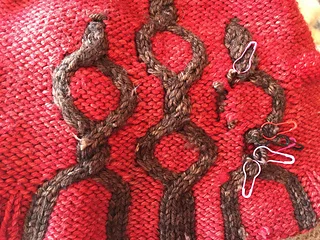Top Down Tapered Sleeves & The Magic Formula
My arms are apparently unusually long. I heard this when I was a child and my archery coach was thrilled with my reach. I realized this every time I tried to buy long sleeved tops. The sleeves always looked a bit too short on me. When I started knitting, I quickly realized that I finally had a solution to this issue. I can alter the pattern! WooHoo! My sleeves are never too short anymore (at least on my sweaters).
Designers are amazing! Writing a pattern is a TON of work. (After writing a draft for this post, designers are even more amazing! It’s really hard work to write out clearly and concisely the steps that you might just knit intuitively). There are so many decisions to make, and I’m not even going to try to talk about the creative side of things!
But everybody’s body is different, so even well-written patterns may need some adjustment for your own body. Hence, my constant sleeve adjustments. I always go through the designer’s instructions, and make length adjustments while trying to maintain the original stye of the pattern (my own personal grading).
So, I thought I’d share my process here because I’m sure there’s a few other people out there who have longer arms…or shorter arms… or arms of a different circumference ratio between the upper arm and the wrist. All of this can be adjusted so you’re comfortable. (On a side note: the formulas I use here can be applied to any other shaping as well i.e. waist shaping).
I decided my first step was to play around with Inkscape and create a schematic of my ideal tapered sleeve:
Tapered Sleeve with 3” of positive ease
To keep things simple, let’s say the gauge I”m working with is 5 sts and 8 rnds per inch. That’s a pretty typical worsted weight gauge for me. Let’s also say I’m knitting these sleeves top-down, I’m picking the sleeve stitches up at the armhole, and I’m not doing capped sleeves. With this information, I can calculate the following:
upper arm circumference - 16” x 5 sts/inch = 80 sts.
wrist circumference - 9” x 5 sts/inch = 45 sts.
sleeve length - 21” x 8 rnds/inch = 168 rnds.
I’m not decreasing throughout the entire sleeve though. If you look at the schematic, I left 1” at the upper arm and 2” at the wrist with no decreases:
sleeve decrease length - 21” - 1” (no shaping at upper arm) = 20” - 1” (no shaping at wrist) = 19” - 1” (cuff ribbing) = 18” x 8 rnds/inch = 144 rnds for decreases.
80 sts - 45 sts = 35 sts. I need to decrease 35 sts over 144 rnds.
This is an odd number, of stitches so I’m going to round down to an even number and decrease 34 stitches. This makes more sense to do since you usually decrease 2 sts at a time on a sleeve, so an even number works and an odd number doesn’t. I decided to round down because I’d rather have more ease at the wrist than less. This means instead of ending with 45 stitches at the wrist, I’ll end with 46 stitches at the wrist.
So, I need to decrease 34 sts over 144 rnds.
Since I’m decreasing 2 sts at a time: 34 sts / 2 = 17 decrease rnds.
I need to have 17 decrease rounds in 144 rounds. I like to make sure these decreases are evenly spaced in relation to the no shaping sections, so I add extra steps here that aren’t normally included in most instructions using the magic formula:
1) Subtract 2 rounds from the total decrease length = 144 rnds - 2 rnds = 142 rnds.
2) Subtract 1 round from the total decrease rounds = 17 decrease rnds - 1 rnd = 16 decrease rnds.
I’m going to add these rounds back in later. They will be used for the very last decrease round I do before working even for the wrist.
Now I apply these numbers to the Magic Formula. Here’s how I figure that out:
142 rnds / 16 decrease rnds = 8 remainder 14
Let’s label these numbers: divisor = A, quotient = B and remainder = C.
To use the magic formula, I do the following two steps:
1)
Decrease 2 sts every B rnds, A-C times =
Decrease 2 sts every 8 rnds, 16-14 times =
Decrease 2 sts every 8 rnds 2x.
2)
Decrease 2 sts every B+1 rnds, C times =
Decrease 2 sts every 8+1 rnds, 14x =
Decrease 2 sts every 9 rnds 14x.
So I combine these 2 calculations into my final answer:
Decrease 2 sts every 8 rnds 2x, then decrease 2 sts every 9 rnds 14x.
(You can do these decreases in any order you like. I often choose to do the decreases that are over more rounds first).
On an important side note: even though I said 2 sts decreased per decrease round, I space my decreases a bit differently than is usually written in a pattern. The typical pattern will say: K1, k2tog, k to 3 sts before end, ssk, k1. I don’t like the way these decreases look because in real life they appear to occur on different rounds (due to the way knitting in the round is actually spiraling). So, I place my decreases so they occur right next to each other on separate rounds (the end of one round and the beginning of the next - see this in the instructions below). This way they are also closer to each other in the spiral and appear to be happening at the same height on the sleeve. This was one of the reasons I adjusted my magic formula.
Now, I’m going to apply these decrease directions to my entire sleeve:
Pick up and knit 80 sts at armhole.
Work in st st for 8 rnds.
Decrease Round 1: Knit to 3 sts before end of rnd, ssk, k1.
Decrease Round 2: K1, k2tog, k to end of rnd.
Work in st st for 7 rnds.
Repeat the previous 9 rnds 13 more times. (52 sts)
Repeat decrease Rounds 1 & 2.
Work in st st for 6 rnds.
Repeat the previous 8 rnds 1 more time. (48 sts)
Repeat decrease Rounds 1 & 2. (46 sts). (This is where I’m adding back in those 2 rounds that I decreased to alter my magic formula).
Work in st st for 8 rnds.
Work in cuff ribbing for 8 rnds. (168 rnds total)
And there you have it! That is how I calculate the shaping for a tapered sleeve to fit my arm length and circumference!






